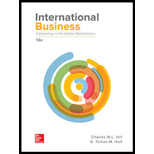
To discuss: The difference in the percentage in foreign direct investment (FDI) inflows in Country I and Country J.
Introduction:
Gross fixed capital formation is the investment in the fixed assets like warehouses, retail stores, and factories.
Explanation of Solution
The difference in the percentage in foreign direct investment (FDI) inflows in Country I and Country J are as follows:
The difference in the percentage in foreign direct investment (FDI) inflows in Country I and Country J mainly because of the government policies
Country I is basically a friendly FDI whereas Country J is not as such kind. Country J does not encourage inward FDI. Though these two countries are trade dependent economies with limited available resources Country I is comparable less mercantile in attitude with that of Country J. Country I has relatively low cost workforce, ample supply of labor and well educated.
Whereas work force of Country J is well educated is more expensive than the Country I.
Want to see more full solutions like this?
Chapter 8 Solutions
International Business: Competing in the Global Marketplace
- There was a noticeable jump in the annual Chinese foreign direct investment (FDI) in Latin America and the Caribbean (LAC) in and since the year 2010. While the annual Chinese FDI was around $5 billion before 2010, it has gone up to $72.5 billion in the last seven years. In the year 2017, China was the largest investor in the LAC in terms of mergers and acquisitions deals of around $18 billion dollars. Between 2005 – 2017, Brazil, Peru, Argentina, Ecuador and Venezuela were top five LAC destinations for the Chinese FDI. Some of the largest acquisitions include Repsol in Brazil (Oil industry), Las Bambas Mine in Peru (Mining industry), Petrogal Brasil in Brazil (Oil industry), Bridas in Argentia (Oil industry), etc. Within the Caribbean, the Alpart Alumina Refinery in Jamaica was sold for US$299 million to the Jiuquan Iron and Steel Company (JISCo). Trinidad & Tobago, along with other Caribbean nations have signed up for the famous “Belt and Road Initiative” of the People’s Republic…arrow_forwardFor every part of this question, assume the reasonable national goals of long term economic growth and business cycle stabilization: a) Discuss a few of the benefits of using the West African franc (WAF). How do these advantages overcome other problems (that occur elsewhere in Africa), where the WAF is not used. b)The WAF currency board is based in Dakar, Senegal. What actions must be taken by the currency board, to guarantee the benefits, discussed in part A? Why is any cheating by the currency board impossible? c) All governments must make tradeoffs. As a result, some people will disagree with their own government. What are some of the identifiable disadvantages of using the WAF? How do these problems occur?arrow_forwardList 10 ways the international monetary fund will exploit its weakness with its strength?arrow_forward
- Due to their rapid expansion to foreign markets the process is sometimes referred to as the “McDonaldization” of new markets. Which market entry strategy is McDonald’s Corporation using in those countries where local governments do not allow 100% foreign funded enterprises?arrow_forwardThe international monetary fund was created through the Bretton Woods agreement as the way to monitor the foreign exchange systems and lend money to developing economies. True Falsearrow_forwardDiscuss at least 10 IMF conditions that must be satisfied by a country with BOP deficit and wishing to borrow money from it?arrow_forward
- You are working for a company that is considering investing in a foreign country. Investing in countries with different traditions is an important element of your company’s long-term strategic goals. As such, management has requested a report regarding the attractiveness of alternative countries based on the potential return of FDI. Write your report to discuss how you would measure country attractive and eventually making a investment choice in a particular country.arrow_forwardWhat adjustments might be made to the domestic cost of capital for a foreign investmentdue to exchange rate risk, political risk, and country risk?arrow_forwardIf your firm is considering investing in Russia, however, after learning that BP's investment is suffering from Ukraine-related sanctions, identify at least 2 reasons why you may want to invest in Russia anyway.arrow_forward
- For the independent nation Eireland in 2019, if GDP = €356.1bn, C = €111.6bn, G = €34.8bn, X = €448.9bn, M = €405.1bn, and with a statistical discrepancy equal to €2bn, then Gross Domestic Fixed Capital Formation is equal to not enough information available €191.1bn €161.9bn €163.9bnarrow_forwardEconomics 4. Foreign direct investment (FDI) comes with certain risks. In the case of Russia, Putin's decision to invade Ukraine has resulted in the seizure of assets in the United States that are owned by sanctioned Russian oligarchs. The US has also prohibited transactions with Russia's central banks. The actions of the US in this example reflect which political view of FDI? A. Radical view B. Market failure view C. Free market view D. Pragmatic nationalismarrow_forwardExamine the criteria that distinguish FDI from other forms of international investment.arrow_forward
 Foundations of Business (MindTap Course List)MarketingISBN:9781337386920Author:William M. Pride, Robert J. Hughes, Jack R. KapoorPublisher:Cengage Learning
Foundations of Business (MindTap Course List)MarketingISBN:9781337386920Author:William M. Pride, Robert J. Hughes, Jack R. KapoorPublisher:Cengage Learning Foundations of Business - Standalone book (MindTa...MarketingISBN:9781285193946Author:William M. Pride, Robert J. Hughes, Jack R. KapoorPublisher:Cengage Learning
Foundations of Business - Standalone book (MindTa...MarketingISBN:9781285193946Author:William M. Pride, Robert J. Hughes, Jack R. KapoorPublisher:Cengage Learning

